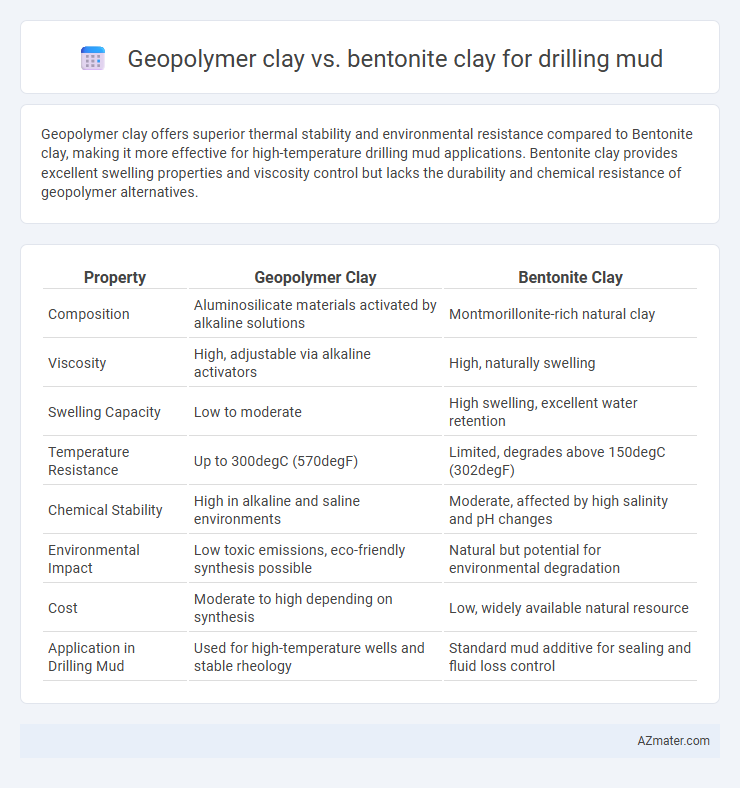Geopolymer clay offers superior thermal stability and environmental resistance compared to Bentonite clay, making it more effective for high-temperature drilling mud applications. Bentonite clay provides excellent swelling properties and viscosity control but lacks the durability and chemical resistance of geopolymer alternatives.
Table of Comparison
| Property | Geopolymer Clay | Bentonite Clay |
|---|---|---|
| Composition | Aluminosilicate materials activated by alkaline solutions | Montmorillonite-rich natural clay |
| Viscosity | High, adjustable via alkaline activators | High, naturally swelling |
| Swelling Capacity | Low to moderate | High swelling, excellent water retention |
| Temperature Resistance | Up to 300degC (570degF) | Limited, degrades above 150degC (302degF) |
| Chemical Stability | High in alkaline and saline environments | Moderate, affected by high salinity and pH changes |
| Environmental Impact | Low toxic emissions, eco-friendly synthesis possible | Natural but potential for environmental degradation |
| Cost | Moderate to high depending on synthesis | Low, widely available natural resource |
| Application in Drilling Mud | Used for high-temperature wells and stable rheology | Standard mud additive for sealing and fluid loss control |
Introduction to Drilling Muds: Importance and Function
Drilling muds are essential for maintaining borehole stability, cooling and lubricating the drill bit, and transporting cuttings to the surface during drilling operations. Geopolymer clay offers enhanced thermal stability and environmental benefits compared to traditional bentonite clay, which is prized for its swelling properties and rheological control. Selecting the appropriate mud type directly impacts drilling efficiency and wellbore integrity in oil and gas exploration.
What is Geopolymer Clay? Composition and Properties
Geopolymer clay is an engineered material composed primarily of aluminosilicate minerals activated by alkaline solutions, creating a three-dimensional polymeric network with high mechanical strength and chemical resistance. Its composition often includes metakaolin, fly ash, or slag combined with sodium hydroxide or potassium hydroxide, resulting in enhanced thermal stability, low permeability, and excellent binding properties suitable for drilling mud applications. Geopolymer clay's unique properties enable superior viscosity control, filtration loss reduction, and improved wellbore stability compared to conventional bentonite clay.
Understanding Bentonite Clay: Characteristics and Uses
Bentonite clay, known for its high swelling capacity and excellent water absorption properties, is widely used in drilling mud to enhance viscosity and fluid loss control. This natural clay consists primarily of montmorillonite, which forms a thixotropic gel that stabilizes boreholes and suspends drill cuttings effectively. In comparison to geopolymer clay, bentonite offers superior chemical inertness and thermal stability, making it a preferred choice in challenging drilling environments.
Key Differences Between Geopolymer and Bentonite Clays
Geopolymer clay exhibits superior thermal stability and enhanced chemical resistance compared to bentonite clay, making it ideal for high-temperature drilling environments. Bentonite clay, composed primarily of montmorillonite, offers excellent swelling capacity and rheological properties essential for creating a stable drilling mud. Key differences include geopolymer clay's synthetic, inorganic polymer structure with high durability versus bentonite's natural, water-absorbing mineral composition, influencing their performance in drilling fluid formulations.
Rheological Properties Comparison in Drilling Applications
Geopolymer clay exhibits superior rheological properties compared to bentonite clay in drilling mud, including higher yield strength and better viscosity stability under high-temperature conditions. Bentonite clay, while commonly used, often experiences significant viscosity loss and reduced gel strength at elevated temperatures, limiting its effectiveness in deep drilling applications. The enhanced thixotropic behavior and improved shear-thinning characteristics of geopolymer clays contribute to more efficient cuttings suspension and easier pumpability, optimizing drilling fluid performance.
Environmental Impact: Geopolymer vs Bentonite Clay
Geopolymer clay exhibits a significantly lower environmental impact compared to bentonite clay in drilling mud applications due to its reduced mining footprint and enhanced recyclability. Unlike bentonite, which involves extensive extraction leading to soil degradation and water contamination risks, geopolymer clay is synthesized from industrial by-products, minimizing destructive resource use. The biodegradable nature and lower toxicity of geopolymer materials contribute to less hazardous waste generation, supporting sustainable drilling practices.
Cost Analysis: Material and Operational Expenses
Geopolymer clay offers cost advantages over Bentonite clay due to lower raw material expenses and reduced environmental disposal fees, resulting in decreased overall material costs for drilling mud formulation. Operational expenses are minimized with geopolymer clay as it requires less water and energy for activation and maintains stable rheological properties under high temperature, reducing fluid loss additives usage. Bentonite clay, while traditionally preferred, incurs higher costs driven by mining, processing, and frequent maintenance to manage viscosity loss and contamination issues during drilling operations.
Performance in Various Geological Formations
Geopolymer clay exhibits superior thermal stability and chemical resistance compared to bentonite clay, making it more effective in high-temperature and highly alkaline drilling environments. Bentonite clay provides excellent swelling properties and fluid loss control in softer formations but tends to degrade in acidic or saline conditions. Geopolymer clay's improved rheological properties enhance drilling fluid stability across diverse geological formations, reducing formation damage and improving borehole integrity.
Sustainability and Future Trends in Drilling Muds
Geopolymer clay offers enhanced sustainability over bentonite clay in drilling mud applications due to its lower environmental footprint, reduced water consumption, and ability to utilize industrial byproducts like fly ash. Bentonite clay remains widely used because of its excellent rheological properties but raises concerns regarding mining impacts and water-intensive processing. Future trends in drilling muds emphasize the development of eco-friendly formulations incorporating geopolymer technology to improve performance while minimizing ecological damage.
Conclusion: Choosing the Right Clay for Drilling Operations
Geopolymer clay offers superior thermal stability and reduced environmental impact compared to Bentonite clay, making it a promising choice for advanced drilling operations. Bentonite clay remains cost-effective and widely available, excelling in swelling capacity and rheological properties critical for traditional drilling mud formulations. Selecting the right clay depends on operational priorities such as temperature resistance, environmental regulations, and budget constraints, with geopolymer clay gaining traction in high-performance or eco-sensitive drilling projects.

Infographic: Geopolymer clay vs Bentonite clay for Drilling mud
 azmater.com
azmater.com